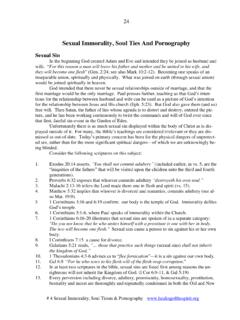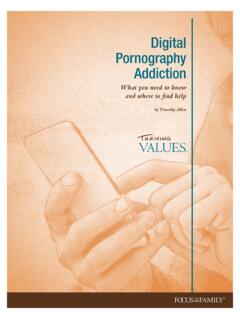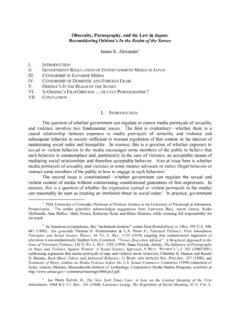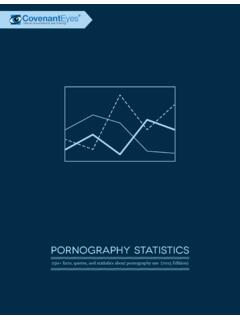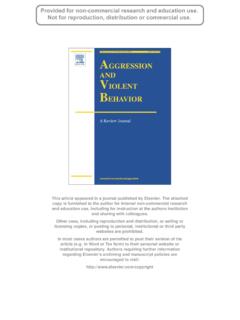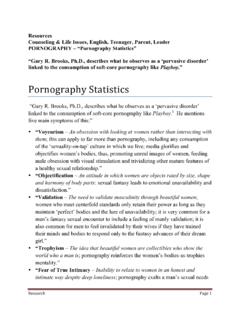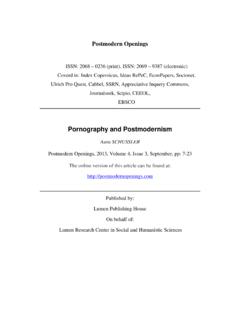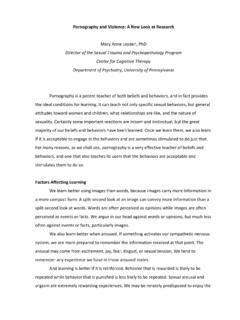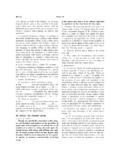Transcription of Exposure to Internet Pornography among Children and ...
1 Exposure to Internet Pornography among Children and Adolescents: A National SurveyMICHELE L. YBARRA, , , and KIMBERLY J. MITCHELL, suggest that up to 90% or more youth between 12 and 18 years have access to the In-ternet. Concern has been raised that this increased accessibility may lead to a rise in pornog-raphy seeking among Children and adolescents, with potentially serious ramifications forchild and adolescent sexual development. Using data from the Youth Internet Safety Survey,a nationally representative, cross-sectional telephone survey of 1501 Children and adolescents(ages 10 17 years), characteristics associated with self-reported Pornography seeking behav-ior, both on the Internet and using traditional methods ( , magazines), are identified. Seek-ers of Pornography , both online and offline, are significantly more likely to be male, withonly 5% of self-identified seekers being female.
2 The vast majority (87%) of youth who reportlooking for sexual images online are 14 years of age or older, when it is developmentally ap-propriate to be sexually curious. Children under the age of 14 who have intentionally lookedat Pornography are more likely to report traditional exposures, such as magazines or about a large group of young Children exposing themselves to Pornography on theInternet may be overstated. Those who report intentional Exposure to Pornography , irrespec-tive of source, are significantly more likely to cross-sectionally report delinquent behaviorand substance use in the previous year. Further, online seekers versus offline seekers aremore likely to report clinical features associated with depression and lower levels of emo-tional bonding with their caregiver.
3 Results of the current investigation raise important ques-tions for further inquiry. Findings from these cross-sectional data provide justification forlongitudinal studies aimed at parsing out temporal sequencing of psychosocial BEHAVIORV olume 8, Number 5, 2005 Mary Ann Liebert, THEINTERNET gains increasing prominence inthe lives of young people,1researchers havebegun investigating the influence that the Internetenvironment may be having on child and particular interest is Exposure tosexual material. Child and adolescent Exposure topornography is a controversial issue. Questionsabout the contribution of Pornography to deviantsexual behavior, including sexual assault, negativeattitudes towards women, and the acceptance of de-viant or aggressive sexual behavior among peers,have been studied for decades.
4 Results are mixed,with some investigators arguing for clear and consis-tent effects of Exposure to Pornography and subse-quent sexually aggressive attitudes and behaviors,3while others describe null or inconclusive ,5 With specific relevance to young people, there is theadditional concern of negative effects on facets ofsexual development, such as sexual callousness, forthose who are exposed to 1 Internet Solutions for Kids, Inc., Irvine, Against Children Research Center, University of New Hampshire, Durham, New 9/28/05 12:22 PM Page 473 Sexual developmentAdolescent sexual development is complex anddynamic. As Children get older, they gain a greatersense of their sexual self,7enhanced by an interplayof biological and social changes as the individualmatures through childhood into adolescence.
5 Al-though puberty begins at different ages, virtually allboys and girls have started the process by 14 yearsof interest increases with age and bio-logical changes, with the average age of first sex ex-perience in the United States being of sexual curiosity spans a continuum ofbehaviors, from talking about sex, looking at sexualmaterials, to actually engaging in sexual activity. Al-though sexual activity can represent risks in and ofitself ( , sexually transmitted diseases), re-searchers and other adolescent health professionalshave posited that Exposure to Pornography may beharm-promoting in other domains as researchThe majority of Pornography studies have beenconducted with 5 This is largely due to theethical and legal considerations of exposing chil-dren and adolescents to potentially harmful mater-ial.
6 A handful of adolescent studies suggest norelationship between Pornography and example, a retrospective study of adolescent sexoffenders found no relationship between prior ex-posure to Pornography and the number of , in a more intensive interview with asub-sample of youths, the majority of offenders de-nied that their use of Pornography in any way led tothe subsequent sex crime. Clearly, more research isneeded about child and adolescent consumption ofpornography. Importantly, as the Internet is used bymore and more young people,1the effects of accessto and Exposure of online Pornography on childand adolescent development will be a child andadolescent health issue of increasing use among Children and adolescentsMore than 90% of young people between theages of 12 and 18 years use the Internet in theUnited vast amount of information isnow widely and easily accessible to anyone whohas an Internet connection.
7 Although positive as-pects of the Internet are frequently cited, includingthe availability of important and sometimes sensi-tive health information10,11,13the often unfetteredaccess to web sites may lead to an overall increasein the numbers of young people seeking out porno-graphic material. To safeguard against this type ofexposure, filtering and blocking software has beendeveloped to prevent access to specific sites, andseveral child-oriented organizations recommendthe usage of such software on home use of blocking software on public computerssuch as those in public libraries remains controver-sial because of free speech of intentional Internet exposuresSeveral studies have asked youth about purpose-ful Exposure to sexual material online. A survey ofyoung people attending a private, urban school inthe Midwest reports that 21% have ever visited apornographic site for at least 3 national tele-phone survey of young people between the ages of12 and 17 found that 15% have lied about their age togain access to a web , this percent-age is similar to the corresponding value observedfor adults in the same , older youths,those with greater months/ years of Internet experi-ence, and those who use the Internet more inten-sively ( , 5+ h/day)
8 Are more likely to reportpurposefully seeking out these ,12 Adolescent beliefs about Internet exposures to sexualmaterialAlthough there are no studies about Exposure tosexual material on the Internet and resulting be-havioral changes, a national study of older teen-agers illuminates concerns about changes in theattitudes and beliefs of young half(59%) of respondents believe that viewing Internetpornography may encourage young people to havesex earlier. Almost one in two respondents (49%)indicate that Internet Pornography promotes nega-tive attitudes towards women, with a similar per-centage (49%) indicating that the images maypromote the perception that unprotected sexual ac-tivity is okay. Beyond perception and belief, noinformation is available about actual outcomes orlinkages between purposeful Exposure to Internetpornography and psychosocial or in current literatureDespite the vast amount of adult literature aboutintentional Exposure to Pornography ,3 5and theemerging reports of adolescent Pornography seek-ing online,10,12 13important questions remain.
9 First,beyond demographic characteristics, what is the474 YBARRA AND 9/28/05 12:22 PM Page 474profile of young person who seek out Pornography ?With the advent of the Internet , it is also importantto begin understanding specific characteristics ofchildren and adolescents who seek Pornography on-line, and investigate whether they differ signifi-cantly from other young people. The Youth InternetSafety Survey, a cross-sectional, nationally represen-tative telephone survey of young people betweenthe ages of 10 and 17 years, provides a unique op-portunity to compare online and offline pornogra-phy seekers with other youth in an effort to informadolescent health and mental health investigation will report important cross-sec-tional associations necessary to justify and informfuture, more complex, longitudinal AND METHODSThe Youth Internet Safety Survey (YISS) was a na-tionally representative telephone survey conductedto quantify the online experiences of Internet -usingyouth (n = 1,501).
10 2It was conducted by researchersat the Crimes against Children Research Center atthe University of New Hampshire. Data were col-lected between the fall of 1999 and spring of methods were approved and supervised bythe University of New Hampshire s Human SubjectsCommittee and adhered to the research guidelinesset forth by the Department of methodThe sample was identified using a national prob-ability design. Phone numbers were generated byanother nationally representative study of youththat was being conducted concurrently, the SecondNational Incidence Study of Missing, Abducted,Runaway, and Thrownaway Children (NISMART-2).14 The phone numbers of households that wereidentified by NISMART-2 as having a youth be-tween the ages of 9 and 17 were forwarded to re-searchers of the YISS (n = 6,594).




